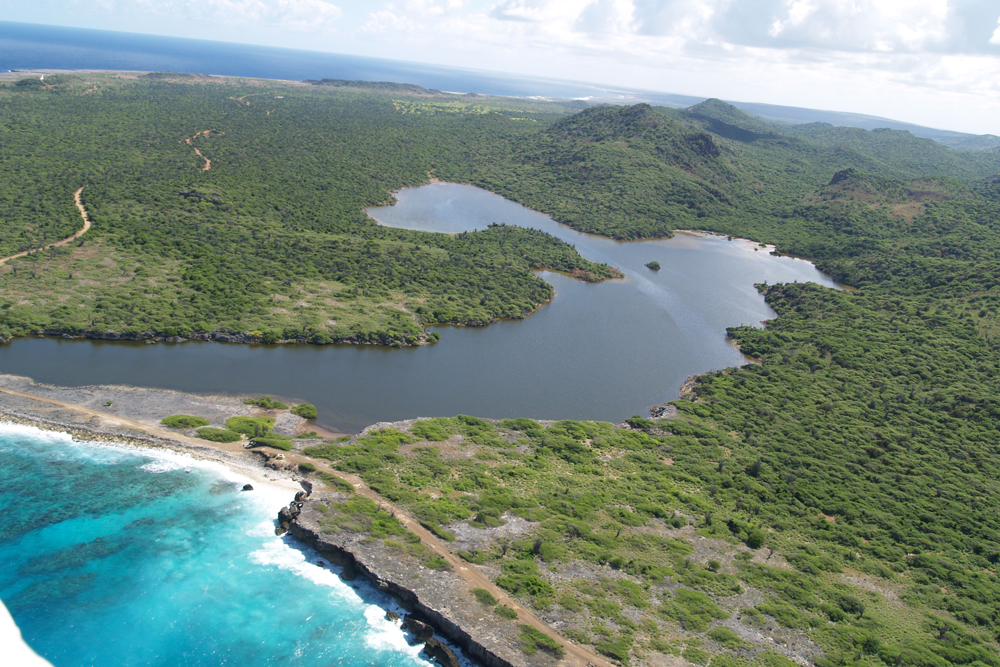
Ancient Caribbean Tsunami Likely Altered Ecosystems

An ancient tsunami caused dramatic long-term ecological changes in the Caribbean more than 3,000 years ago, new research suggests.
Scientists investigated sediments from a coastal lagoon on the Caribbean island of Bonaire about 50 miles (80 kilometers) north of the Venezuelan coast. The Caribbean is highly vulnerable to coastal hazards such as hurricanes, tsunamis, mudslides and floods.
Bonaire has not experienced a tsunami during the past 500 years of its recorded history. However, analysis of the size of sediment grains found on the island, the organic matter present in the sediment (such as animal remains and carbonate minerals), as well as other factors suggest that a devastating wave struck the island about 3,000 to 3,300 years ago.
"We assume that the height of the ancient tsunami along the coast was at least 8 to 9 meters [26 to 30 feet] as inferred from the size of transported boulders," said researcher Max Engel, a coastal geomorphologist at the University of Cologne in Germany. [7 Ways the Earth Changes in the Blink of an Eye]
Altered ecosystem
The researchers estimate the tsunami reached at least 820 feet (250 m) onshore. "Lagoons and valleys of the island might be inundated up to a kilometer [0.6 miles] or more, and the flat and low-lying southern tip of the island might have been entirely inundated," Engel told OurAmazingPlanet.
This catastrophe apparently altered the coastal ecosystem and sedimentation patterns in the area. In the wave's aftermath, a barrier of coral rubble separated a former mangrove-fringed bay from the open sea, transforming it into a highly salty lagoon that has persisted up to now.
Sign up for the Live Science daily newsletter now
Get the world’s most fascinating discoveries delivered straight to your inbox.
"Large tsunamis may occur on the ABC islands — Aruba, Bonaire, Curaçao — even though tsunamis have never been observed in historical times," Engel said.
Uncertain source
It remains uncertain where this tsunami might have come from. "The most likely source would be a local to regional tsunami triggered by an earthquake along the southern boundary of the Caribbean tectonic plate — that is, the coast of Venezuela," Engel said. For instance, historical records suggest a devastating tsunami in 1530 was triggered by an earthquake near Cumaná, Venezuela.
In addition, a strong earthquake at the northeastern boundary of the Caribbean cannot be excluded as the tsunami's cause either. For instance, the 1867 temblor in the Anegada Passage in the U.S. Virgin Islands triggered a tsunami that traveled across the Caribbean. "Further possible trigger mechanisms include submarine volcanic activity in the southern Antilles island arc, though these tsunamis tend to be local," Engel said.
The wave may even have been a "teletsunami," an oceanwide tsunami originating on the other side of the Atlantic.
"For instance, computer models indicate that the collapse of a flank of the Cumbre Vieja volcano in the Canary Islands into the sea may induce a tsunami that still reaches a height of several meters after crossing the Atlantic Ocean and approaching the Caribbean islands and the southern coasts of North America," Engel said.
The investigators said further studies should look for evidence of tsunamis across the entire Caribbean to reconstruct reliable patterns of tsunami magnitude, frequency and location, as well as their environmental impact. In addition, researchers should develop computer models simulating earthquake-triggered tsunamis capable of creating the pattern of coastal flooding on Bonaire that matches the geological evidence to identify a possible trigger mechanism posing a threat in the future.
"We provided evidence for a potential hazard for which there is no real awareness on Bonaire," Engel said. "I hope this work contributes to an increase in public awareness on a local and regional level."
Engel and his colleagues detailed their findings in the January issue of the journal Naturwissenschaften.
This story wa provided by OurAmazingPlanet, a sister site to LiveScience. Follow OurAmazingPlanet for the latest in Earth science and exploration news on Twitter @OAPlanet. We're also on Facebook & Google+.

Crop circles surround Iraq's multicolored 'Sea of Salt' after years of drought — Earth from space
Watch humanlike robot with bionic muscles dangle as it twitches, shrugs and clenches its fists in creepy video
'The parasite was in the driver's seat': The zombie ants that die gruesome deaths fit for a horror movie










